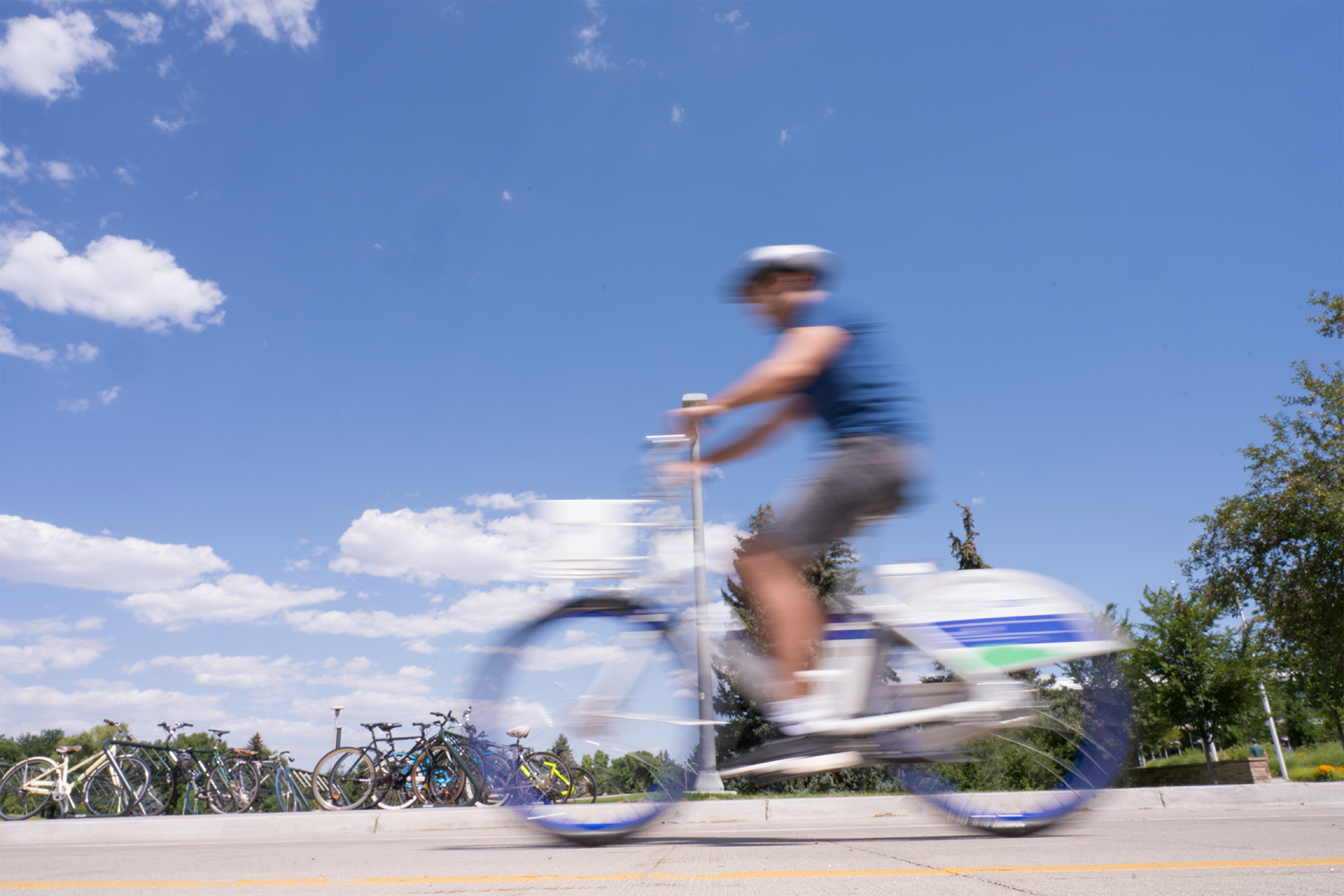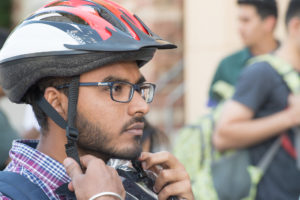
CSU has transformed from a “car commuter campus” to one that can be accessed by all means of transportation.
Aaron Fodge believes in pedal power.
At any opportunity Fodge, Colorado State University’s manager of alternative transportation, enthusiastically extols the benefits of traveling to, from, and around the campuses using anything but a car.
“My job is to convince every person at CSU that it’s in their individual best interest to do something different and use alternative transportation,” he said. “Riding a bike to work or school increases quality of life. It’s fun, it’s great exercise, it’s cheaper than driving a car, and is just better for our campus.”
Fodge, who has served as the University’s first alternative transportation manager for six years, leads by example and commutes by bike to and from main campus – 2 miles each way – every day, rain, shine or snow. His passion reflects CSU’s commitment to alternative transportation that has evolved from recent increases in the campus population, new construction, and increasing emphasis on sustainability.
Collaborative mission
Through his dedication to the mission of encouraging alternative transportation and a collaborative mission with divisions, departments and individuals on campus and the city of Fort Collins, Fodge has led the transformation of CSU from what he calls a “car commuter campus” to one that can be accessed by all means of transportation.
“Our university partners have made this university more successful by removing barriers to accessing our campuses,” said Fodge, who cites the addition of Around the Horn, the on-campus bus shuttle and the MAX transportation line that runs along the Mason Street Corridor, as well as a dramatic increase in the number of bike lanes to and through main and south campuses as safe and efficient improvements to campus access.
Additionally, CSU has worked closely with the city to increase the number and locations of Transfort bus routes that more efficiently shuttle students, employees and visitors to and from campus.
“The changes that this university has seen in the past several years with regard to mobility is staggering and exciting.”
— Lynn Johnson, vice president for university operations
“The changes that this university has seen in the past several years with regard to mobility is staggering and exciting,” said Lynn Johnson, vice president for university operations. “We have crisscrossed the main, south and foothills campuses with more than 15 miles of trails and lanes allowing easy access to human-powered and electric vehicles, and are reducing the number of cars, making it safer and more environmentally friendly.”
Hard data and personal experiences
Fodge and university officials use hard data and personal experiences to create the university mobility strategy and determine where access should be improved, added or adjusted to ensure safety. For example, Fodge and his team conducted 120 interviews with employees and students to determine alternative transportation behaviors, concerns and usage.
By studying employee home addresses and student commuter patterns, the team has been able to add bike access where it is most needed. The research shows that approximately 1,200 CSU employees and more than 5,000 students live within one-half mile of the Pitkin Bikeway, and as a result of that statistic and a collaborative relationship with the city, the Pitkin Bikeway is now one of three city bike trails that dissect campus. The other two are the Center Bikeway and the Mason Trail.
Based on survey results and data, Fodge and his team have created programs targeting specific campus groups. CSU Moves is an online course offered to students to learn more about alternative transportation at CSU – and a chance to win prizes, gift cards, even a new bike. Back on the Bike helps faculty and staff 50 years old or older looking for assistance in plotting best routes, reviewing safety best practices, and winter bicycle commuting to and from work.
CSU alternative transportation by the numbers
42% of CSU students use alternative transportation (bus, bike, skateboard) between campus and home; 26% walk
29% of faculty members use alternative transportation to and from work
21% of all other University employees use alternative transportation to and from work
There are more than 17,000 bike parking spots on campus
8,000 bicycles use the Green Trail (south of Moby arena) during an average school day in the fall
5,000 students and 1,200 CSU employees live within one-half miles from the Pitkin Bikeway, which runs through main campus
There are more than 15 miles of bike trails on the three CSU campuses (main, south, foothills)
Safety first

Whether developing a plan to commute to class or work, or simply to enjoy CSU’s beautiful campuses, Fodge said the first priority always has to be safety. Is the plan safe for the bike rider, e-scooter driver, or skateboarder? Is the pedestrian protected? Are automobile drivers aware of where trails and paths cross intersections? Whether riding a bike, driving an e-scooter (which will be available for rent on campus beginning in September), or walking from a bus stop, Fodge said commuters have to feel confident and protected.
“We want to encourage and empower people to use alternative transportation by providing safe and efficient routes,” he said. “We don’t want them to feel intimidated or afraid to leave their cars at home because of a bad experience or because they don’t know the safest route to take.”
To ensure comfort and inspiration, Fodge and his team will create a personalized commuter plan for any employee or student who wants to discover the best and safest route for them to commute to campus from home.
Just call us and we’ll plot your route,” Fodge said. “It might take you a bit longer than driving – or maybe not – but using alternative transportation to get to work and home again is good for your physical and mental health, and the environment. No excuses!”
Find out more about options for alternative transportation.
Bicycle-specific information is here.
View an interactive campus map of alternative transportation routes.